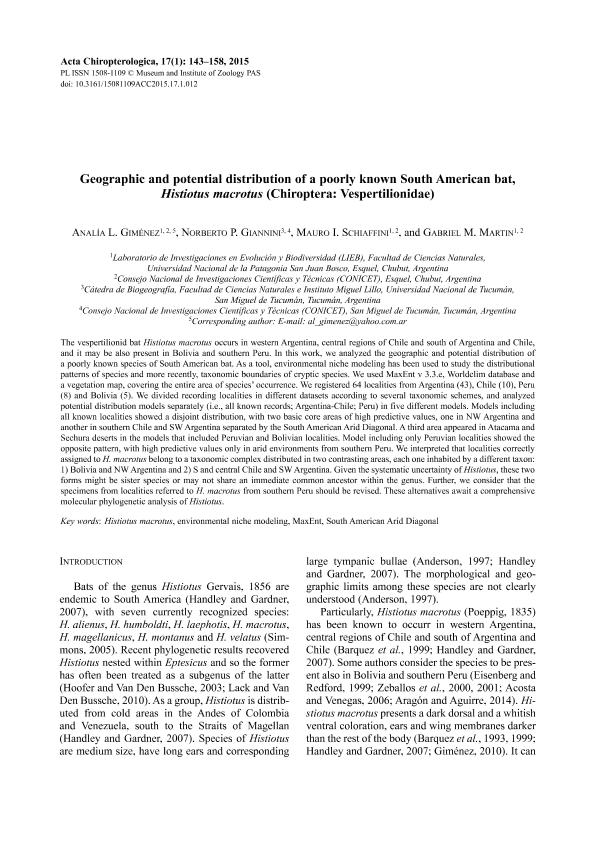Mostrar el registro sencillo del ítem
dc.contributor.author
Giménez, Analía Laura

dc.contributor.author
Giannini, Norberto Pedro

dc.contributor.author
Schiaffini, Mauro Ignacio

dc.contributor.author
Martin, Gabriel Mario

dc.date.available
2018-02-27T21:28:48Z
dc.date.issued
2015-06
dc.identifier.citation
Giménez, Analía Laura; Giannini, Norberto Pedro; Schiaffini, Mauro Ignacio; Martin, Gabriel Mario; Geographic and potential distribution of a poorly known south American bat, Histiotus macrotus (Chiroptera: Vespertilionidae); Polish Academy of Sciences; Acta Chiropterologica; 17; 1; 6-2015; 143-158
dc.identifier.issn
1508-1109
dc.identifier.uri
http://hdl.handle.net/11336/37356
dc.description.abstract
The vespertilionid bat Histiotus macrotus occurs in western Argentina, central regions of Chile and south of Argentina and Chile, and it may be also present in Bolivia and southern Peru. In this work, we analyzed the geographic and potential distribution of a poorly known species of South American bat. As a tool, environmental niche modeling has been used to study the distributional patterns of species and more recently, taxonomic boundaries of cryptic species. We used MaxEnt v 3.3.e, Worldclim database and a vegetation map, covering the entire area of species' occurrence. We registered 64 localities from Argentina (43), Chile (10), Peru (8) and Bolivia (5). We divided recording localities in different datasets according to several taxonomic schemes, and analyzed potential distribution models separately (i.e., all known records; Argentina-Chile; Peru) in five different models. Models including all known localities showed a disjoint distribution, with two basic core areas of high predictive values, one in NW Argentina and another in southern Chile and SW Argentina separated by the South American Arid Diagonal. A third area appeared in Atacama and Sechura deserts in the models that included Peruvian and Bolivian localities. Model including only Peruvian localities showed the opposite pattern, with high predictive values only in arid environments from southern Peru. We interpreted that localities correctly assigned to H. macrotus belong to a taxonomic complex distributed in two contrasting areas, each one inhabited by a different taxon: 1) Bolivia and NW Argentina and 2) S and central Chile and SW Argentina. Given the systematic uncertainty of Histiotus, these two forms might be sister species or may not share an immediate common ancestor within the genus. Further, we consider that the specimens from localities referred to H. macrotus from southern Peru should be revised. These alternatives await a comprehensive molecular phylogenetic analysis of Histiotus.
dc.format
application/pdf
dc.language.iso
eng
dc.publisher
Polish Academy of Sciences

dc.rights
info:eu-repo/semantics/openAccess
dc.rights.uri
https://creativecommons.org/licenses/by-nc-sa/2.5/ar/
dc.subject
Environmental Niche Modeling
dc.subject
Histiotus Macrotus
dc.subject
Maxent
dc.subject
South American Arid Diagonal
dc.subject.classification
Otras Ciencias Biológicas

dc.subject.classification
Ciencias Biológicas

dc.subject.classification
CIENCIAS NATURALES Y EXACTAS

dc.title
Geographic and potential distribution of a poorly known south American bat, Histiotus macrotus (Chiroptera: Vespertilionidae)
dc.type
info:eu-repo/semantics/article
dc.type
info:ar-repo/semantics/artículo
dc.type
info:eu-repo/semantics/publishedVersion
dc.date.updated
2018-02-20T17:09:21Z
dc.identifier.eissn
1733-5329
dc.journal.volume
17
dc.journal.number
1
dc.journal.pagination
143-158
dc.journal.pais
Polonia

dc.journal.ciudad
Bialowieza
dc.description.fil
Fil: Giménez, Analía Laura. Consejo Nacional de Investigaciones Científicas y Técnicas. Centro Científico Tecnológico Conicet - Patagonia Norte. Centro de Investigación Esquel de Montaña y Estepa Patagóica. Universidad Nacional de la Patagonia ; Argentina. Universidad Nacional de la Patagonia "San Juan Bosco". Facultad de Ciencias Naturales - Sede Esquel. Laboratorio de Investigaciones en Evolución y Biodiversidad; Argentina
dc.description.fil
Fil: Giannini, Norberto Pedro. Universidad Nacional de Tucumán. Facultad de Ciencias Naturales e Instituto Miguel Lillo; Argentina. Consejo Nacional de Investigaciones Científicas y Técnicas; Argentina
dc.description.fil
Fil: Schiaffini, Mauro Ignacio. Universidad Nacional de la Patagonia "San Juan Bosco". Facultad de Ciencias Naturales - Sede Esquel. Laboratorio de Investigaciones en Evolución y Biodiversidad; Argentina. Consejo Nacional de Investigaciones Científicas y Técnicas. Centro Científico Tecnológico Conicet - Patagonia Norte. Centro de Investigación Esquel de Montaña y Estepa Patagóica. Universidad Nacional de la Patagonia ; Argentina
dc.description.fil
Fil: Martin, Gabriel Mario. Universidad Nacional de la Patagonia "San Juan Bosco". Facultad de Ciencias Naturales - Sede Esquel. Laboratorio de Investigaciones en Evolución y Biodiversidad; Argentina. Consejo Nacional de Investigaciones Científicas y Técnicas. Centro Científico Tecnológico Conicet - Patagonia Norte. Centro de Investigación Esquel de Montaña y Estepa Patagóica. Universidad Nacional de la Patagonia ; Argentina
dc.journal.title
Acta Chiropterologica

dc.relation.alternativeid
info:eu-repo/semantics/altIdentifier/doi/http://dx.doi.org/10.3161/15081109ACC2015.17.1.012
dc.relation.alternativeid
info:eu-repo/semantics/altIdentifier/url/http://www.bioone.org/doi/10.3161/15081109ACC2015.17.1.012
Archivos asociados
